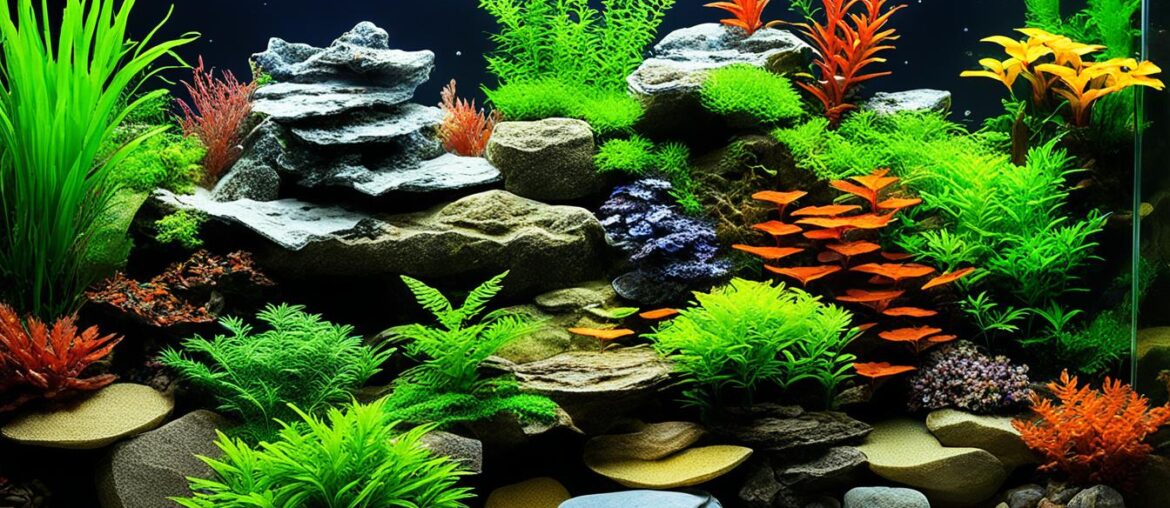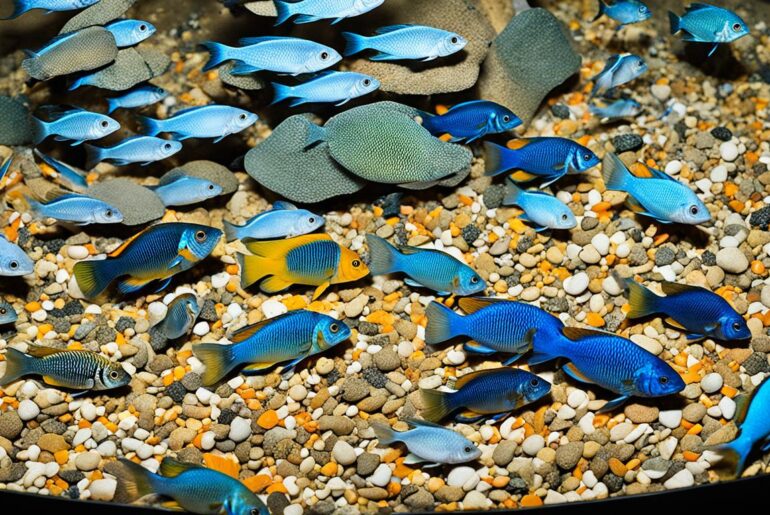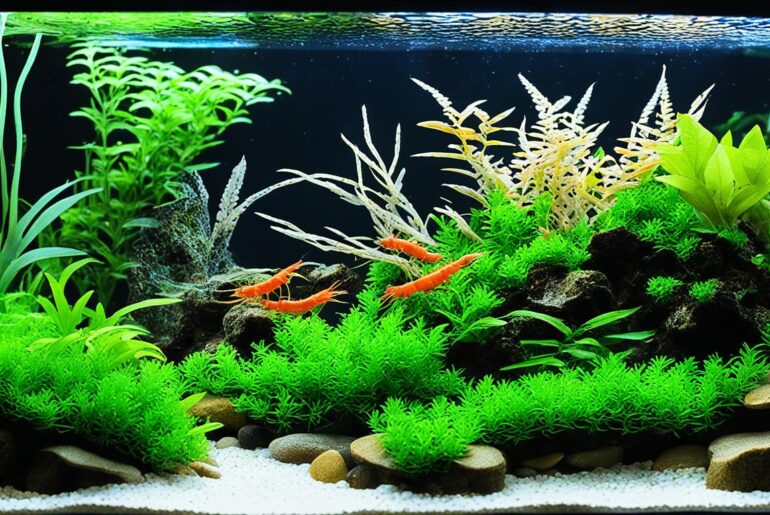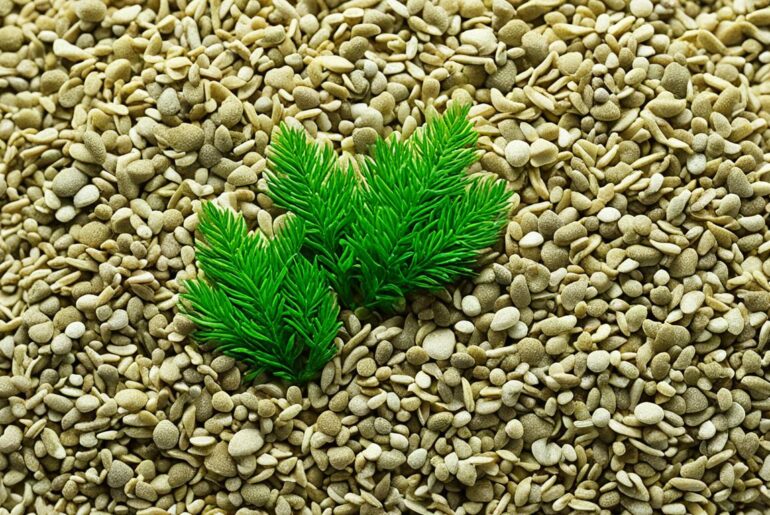Imagine having a peaceful oasis right in your own home, filled with vibrant aquatic plants and colorful fish that captivate your senses. That’s the beauty of a freshwater tank, a slice of nature that brings tranquility and joy to your everyday life.
But as any fish keeper knows, creating and maintaining a healthy aquarium ecosystem takes careful consideration and attention to detail. One crucial factor that can make all the difference is the choice of substrate for your tank.
Whether you’re a seasoned aquarist or just starting out, selecting the right substrate is essential for ensuring a low-maintenance tank that thrives with minimal effort. It sets the foundation for a balanced environment, providing nutrients for plants, a habitat for beneficial bacteria, and a comfortable space for your fish.
In this article, we will explore 10 substrate choices for low-maintenance freshwater tanks, each with its own unique qualities and considerations. From gravel to sand, soil to clay, we’ll guide you through the options to help you make an informed decision and create a thriving aquatic ecosystem that requires less time and effort.
Key Takeaways:
- Choosing the right substrate is crucial for creating a healthy and low-maintenance freshwater tank.
- Gravel, sand, soil, and clay are just a few options to consider, each offering different benefits for your aquatic plants and fish.
- Consider the specific needs of your tank, such as plant growth, pH levels, and the preferences of your fish species, when selecting a substrate.
- Combining multiple substrates can create a natural and visually appealing environment.
- With the right substrate choice, you can enjoy the beauty of a freshwater tank while spending less time on maintenance.
Gravel – A Versatile and Practical Option
When it comes to choosing the right substrate for your freshwater tank, gravel is a popular choice that offers both versatility and practicality. With a wide variety of colors and sizes available, it’s easy to find gravel that not only suits your aesthetic preferences but also provides a functional base for your aquatic environment.
A key advantage of using gravel in your tank is its ease of cleaning. Uneaten food and debris can be easily vacuumed from the surface, helping to maintain a clean and healthy habitat for your fish. Regular clean-up not only prevents excess waste buildup but also promotes better water quality, reducing the risk of algae growth and other potential issues.
It’s important to choose gravel with smooth edges to ensure the safety of your fish. A rough gravel substrate can harm sensitive species, causing injury or stress. By selecting gravel with rounded edges, you can create a comfortable environment where your fish can swim and explore freely without risking their well-being.
Gravel provides a sturdy foundation for anchoring plants in your tank. Additionally, it facilitates the growth of beneficial bacteria that help maintain water quality and support the overall ecosystem. The textured surface of gravel provides ample surface area for beneficial bacteria to colonize, aiding in the natural biological filtration of your tank.
“Gravel is a versatile substrate choice for freshwater tanks, offering practicality and aesthetic appeal. With proper cleaning and maintenance, it promotes a healthy aquatic environment for your fish and plants.”
Key Features of Gravel as a Freshwater Tank Substrate:
- Wide variety of colors and sizes
- Easy to clean and maintain
- Provides a comfortable habitat for fish
- Sturdy base for anchoring plants
- Promotes beneficial bacteria growth
Considerations When Using Gravel:
- Choose gravel with smooth edges to prevent harm to fish
- Regularly vacuum the surface to remove debris and maintain water quality
- Provide additional filtration to ensure optimal water conditions
By carefully selecting and maintaining the gravel substrate in your freshwater tank, you can create a visually appealing and functional environment that supports the well-being of your fish and plants.
Soil – Ideal for Plant Growth
Aquarium soil is a fantastic substrate choice for freshwater tanks that prioritize the growth of aquatic plants. Designed to remain solid in water, aquarium soil provides essential nutrients that support healthy plant development. It is crucial to use specific aquarium soil rather than regular soil, as the latter can introduce toxins and bacteria into the tank, compromising the overall ecosystem. Typically available in natural brown colors, aquarium soil can also be combined with other substrates to enhance the visual appeal of your tank.
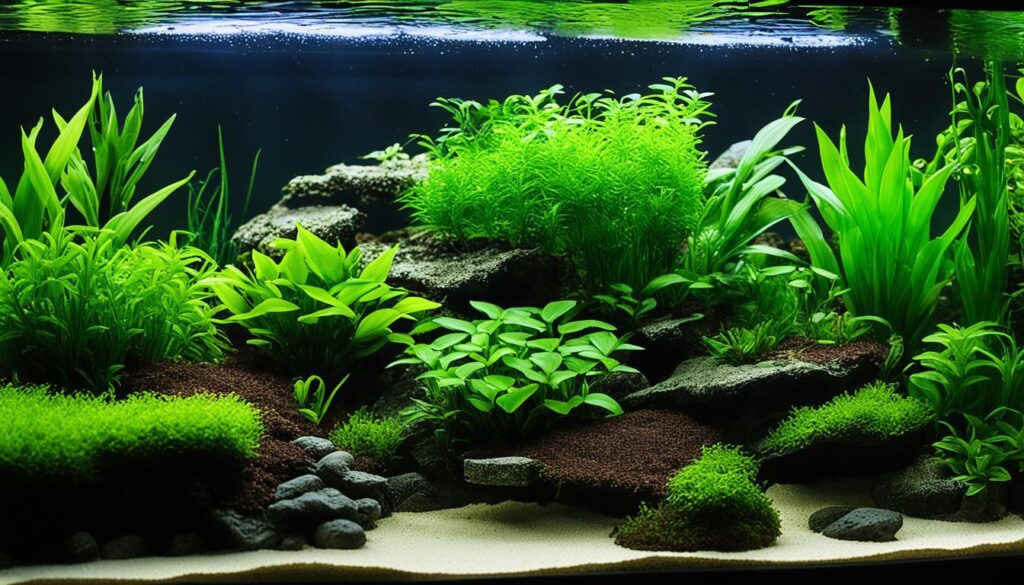
One of the primary advantages of using soil as a substrate is its ability to secure and nourish plant roots. The soil particles create a stable foundation for the plants, promoting proper root growth and overall plant health. With the right soil, you can create an ideal environment for lush and vibrant aquatic plants in your tank.
When selecting aquarium soil, it’s important to consider the specific needs and preferences of your fish and plant species. Different brands and types of soil offer varying nutrient profiles, pH levels, and compatibility with different species. Researching and selecting the appropriate aquarium soil will ensure optimal conditions for plant growth and a thriving tank ecosystem.
Sand – Natural and Easy to Clean
When it comes to choosing a substrate for your freshwater tank, sand is a fantastic option that offers both natural aesthetics and easy maintenance. With its various grain sizes and colors, sand allows you to create a visually appealing aquarium that complements your fish and plants.
One of the main advantages of using sand as your aquarium substrate is its easy cleaning process. Unlike other substrates that may trap debris and waste, sand allows you to quickly remove any unwanted particles, keeping your tank clean and healthy. Regular vacuuming of the sand surface will help maintain water quality and prevent the accumulation of harmful substances.
Sand is particularly well-suited for fish species that prefer a sandy environment. Many bottom-dwelling fish, such as catfish and loaches, enjoy sifting through sand in their search for food or creating nests. By providing a sand substrate, you can create a habitat that closely resembles their natural environment, ensuring the well-being and happiness of your fish.
Moreover, sand can be easily mixed with other substrates to create unique styles and textures in your aquarium. Combining sand with rocks, driftwood, or plants can add depth and visual interest to your tank, making it a stunning centerpiece in any room. Be sure to choose sand that is aquarium-safe and free from any harmful chemicals or impurities.
In conclusion, sand serves as a natural and low-maintenance substrate option for your freshwater tank. Its easy cleaning process, compatibility with bottom-dwelling fish, and versatility in creating visually appealing aquarium layouts make it a popular choice among aquarium enthusiasts. Consider incorporating sand into your tank setup to provide a natural and comfortable habitat for your aquatic pets.
Aragonite – pH Stabilizer and Buffer
Aragonite is a type of sand that contains calcium carbonate, which gradually raises and stabilizes the pH level of the water. It is particularly beneficial for tanks that require higher pH levels. While commonly used in reef aquariums, small amounts of aragonite can be added to freshwater tanks, depending on the fish species’ preferences. It is important to monitor the pH levels consistently and choose aragonite accordingly.
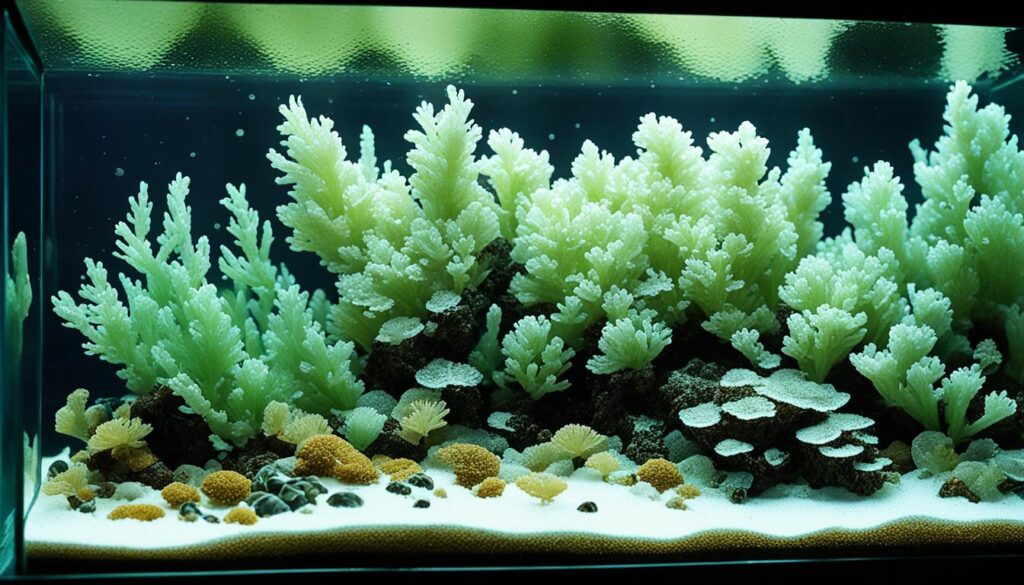
Benefits of Aragonite for Freshwater Tanks
- Stabilizes pH levels: Aragonite helps maintain a stable pH environment in the tank, benefiting the overall health of the fish and plants.
- Provides a natural buffer: The calcium carbonate present in aragonite acts as a natural buffer, helping to prevent sudden pH fluctuations in the water.
- Enhances water hardness: Aragonite can increase the water’s hardness, which is necessary for certain fish species that thrive in alkaline conditions.
“Adding aragonite to my freshwater tank has made a noticeable difference in maintaining a stable pH level. It has greatly improved the overall health and vitality of my fish and plants.” – Aquarium enthusiast
When using aragonite as a substrate in a freshwater tank, it is important to consider the specific needs of your fish species and monitor the pH levels regularly. Aragonite is available in various forms such as fine sand or gravel, allowing you to choose the one that suits your aesthetic preferences. Incorporating aragonite into your tank can provide a natural and effective way to stabilize pH levels and create a healthy aquatic environment.
Vermiculite – Nutrient-rich and Plant-friendly
When it comes to freshwater tank substrates, vermiculite stands out as an excellent choice for nurturing aquatic plants. Made from a combination of minerals, this substrate slowly releases potassium and magnesium into the water, providing essential nutrients for plant growth.
One of the advantages of vermiculite is its compatibility with other substrates. When combined with gravel, it creates a supportive environment for plants, offering ample material for their roots to anchor and grow. This combination not only enhances the visual appeal of your tank but also contributes to the overall health and vitality of your plants.
If your aim is to create a thriving aquatic plant ecosystem, vermiculite should be a top consideration. Its nutrient-rich composition promotes robust growth and helps maintain a balanced and healthy tank environment.
Benefits of Vermiculite for Freshwater Tanks:
- Slow release of essential nutrients like potassium and magnesium
- Supports healthy growth of aquatic plants
- Complements other substrates, especially gravel
- Enhances the aesthetic appeal of the tank
Investing in vermiculite as your freshwater tank substrate ensures that your plants receive the necessary nutrients for optimal development. Its ability to work harmoniously with other substrates makes it a versatile option that caters to both the needs of your plants and the visual design of your tank.
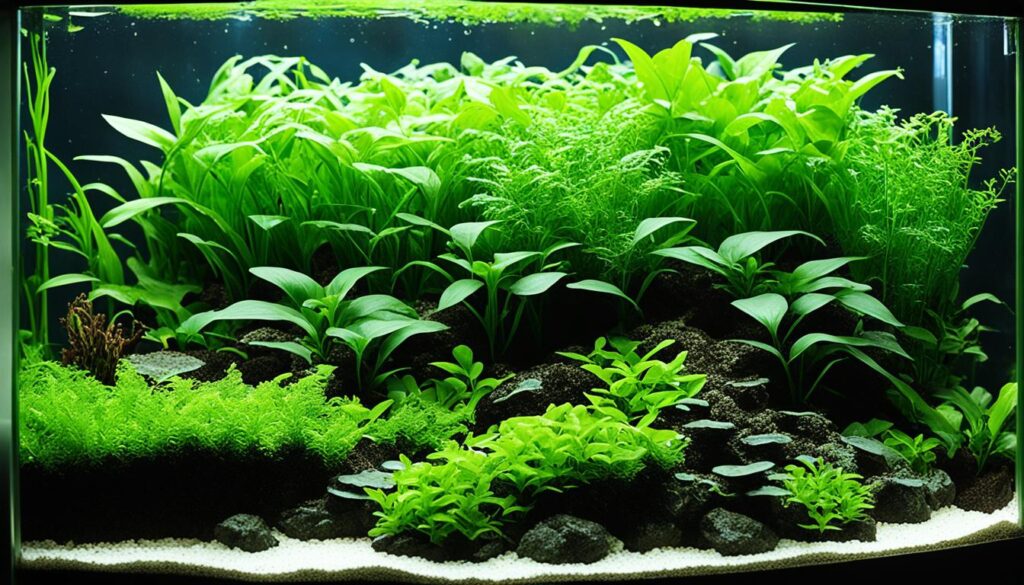
| Vermiculite | Benefits |
|---|---|
| Nutrient-rich composition | Slow release of potassium and magnesium |
| Promotes plant growth | Supports healthy roots and overall plant vitality |
| Compatibility with other substrates | Works well with gravel, enhancing aesthetic appeal |
Peat Moss – Natural Water Buffer
When it comes to finding suitable substrates for fish tanks, peat moss stands out as a natural water buffer that can help balance pH levels and soften hard water. As an organic option without fertilizers or chemicals, peat moss offers a safe and effective solution for maintaining optimal water conditions in your aquarium.
To prepare peat moss for use in your aquarium, it’s recommended to soak it in water for a few days. This process helps to balance the pH levels and remove any impurities. After soaking, the peat moss can be spread as a substrate layer or used as a filter material to create a natural and healthy environment for your fish.
It’s important to note that to prevent any potential harm to your fish, it’s advisable to boil the peat moss before adding it to the tank. This step ensures that any unwanted substances or microorganisms are eliminated, promoting the well-being of your aquatic pets.
| Pros | Cons |
|---|---|
| Acts as a natural water buffer | Requires proper preparation before use |
| Softens hard water | Should choose organic options without fertilizers or chemicals |
| Creates a natural and healthy environment for fish | Recommended to boil before adding to the tank |
Peat moss offers a natural and effective way to buffer water and create an optimal habitat for your fish. By following the proper preparation steps, you can ensure that your aquarium maintains the ideal conditions for the well-being of your aquatic pets.
Coral – pH Stabilizer and Preferred by Some Fish Species
When it comes to choosing suitable substrates for freshwater tanks, crushed corals offer a range of benefits. Not only are they effective for maintaining stable pH levels, but they are also preferred by certain fish species, such as African cichlids, that thrive in hard water.
Crushed coral substrates can contain a mix of corals and aragonite, providing multiple advantages for your aquarium. The coral helps stabilize the pH levels, ensuring a healthy and balanced environment for your fish. The addition of aragonite contributes to the overall hardness of the water, which can be beneficial for specific species.
It’s important to choose the right type of coral substrate based on the specific needs of your fish. Different corals have varying effects on water chemistry. Some may raise the pH significantly, while others have a more subtle impact. Researching the requirements of your fish species is essential in determining the appropriate coral substrate.
| Coral Type | Effects on pH |
|---|---|
| Corals A | Raises pH by 1.0-1.5 |
| Corals B | Raises pH by 0.5-1.0 |
| Corals C | Negligible effect on pH |
By selecting the appropriate coral substrate, you can ensure that your fish thrive in an environment that closely mimics their natural habitat. Remember to monitor and adjust the pH levels regularly to maintain the optimal conditions for your fish species.

To summarize, crushed coral substrates serve as a pH stabilizer in reef aquariums and are suitable for certain freshwater fish species. Their ability to influence pH levels and provide a natural environment makes them a popular choice among aquarium enthusiasts. By carefully selecting the right coral substrate, you can create a beautiful and harmonious underwater ecosystem for your fish to thrive in.
Clay – Ideal for Plant Growth and Water Filtration
Clay substrates, such as fluorite, are an excellent choice for freshwater tanks, especially if you want to promote lush and thriving aquatic plant growth. These substrates offer a host of benefits, including effective water filtration and the ability to handle ammonia efficiently. The natural porous structure of clay helps to retain nutrients while allowing beneficial bacteria to flourish, contributing to a healthy and balanced tank ecosystem.
One popular clay substrate, fluorite, stands out for its durability and stability. Unlike some other substrates, fluorite does not disintegrate or compact over time, ensuring a consistent and reliable planting medium for years to come. This makes it a preferred choice for many fish keepers who appreciate its long-lasting performance.
The Benefits of Clay Substrates
- Promote healthy plant growth: Clay substrates provide an ideal environment for aquatic plants, offering sufficient nutrients and a stable base for their roots to anchor.
- Effective water filtration: The porous nature of clay helps to filter water, removing impurities and maintaining water quality.
- Ammonia handling: Clay substrates have the ability to handle ammonia, which is especially crucial in new tanks or when introducing new fish.
- Durability: Clay substrates like fluorite remain stable and intact over time, ensuring a long-lasting investment for your freshwater tank.
In addition to its functional benefits, clay substrates can also enhance the aesthetic appeal of your tank. The natural earthy tones of clay provide a visually pleasing backdrop that complements the vibrant colors of fish and plants.
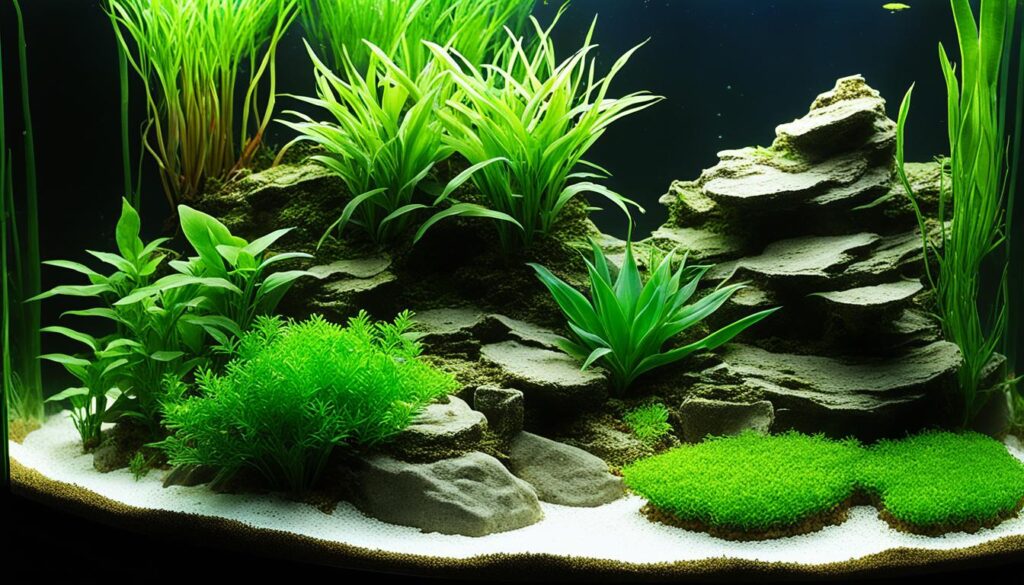
| Advantages of Clay Substrates | Disadvantages of Clay Substrates |
|---|---|
|
|
Conclusion
The choice of substrate for a low-maintenance freshwater tank is a crucial decision that depends on several factors. Considerations such as tank size, fish species, and desired aesthetic all play a role in selecting the right substrate. Gravel, soil, sand, aragonite, vermiculite, peat moss, coral, marbles, and clay are all viable options with their unique advantages and considerations.
Creating layers using multiple substrates can help create a natural environment and support plant growth in your tank. It’s important to research each substrate and understand how it will interact with your specific needs. By selecting a suitable substrate, you can ensure the health and low-maintenance of your freshwater tank.
Remember, maintaining a healthy tank is a continuous process, and regular monitoring and maintenance are essential. Proper substrate selection is just one aspect of creating an optimal environment for your aquatic plants and fish. So, take the time to educate yourself, make informed decisions, and enjoy the beauty of a thriving freshwater tank.
FAQ
What is the best substrate for a low-maintenance freshwater tank?
The best substrate for a low-maintenance freshwater tank depends on various factors, including the tank size, fish species, and desired aesthetic. Gravel, soil, sand, aragonite, vermiculite, peat moss, coral, marbles, and clay all offer unique advantages and considerations. Building layers using multiple substrates is another option for creating a natural environment and supporting plant growth. Ultimately, it is essential to research and select a substrate that suits your specific needs and keeps your freshwater tank healthy and low-maintenance.
What are the advantages of using gravel as a substrate for a freshwater tank?
Gravel is a popular choice for many freshwater tanks due to its versatility and practicality. It comes in a wide variety of colors and sizes, making it easy to find one that suits your aesthetic preferences. Gravel is also easy to clean, as uneaten food and debris can be vacuumed from its surface. However, it’s important to choose gravel with smooth edges to avoid harming sensitive fish species.
Why is aquarium soil an ideal choice for plant growth in freshwater tanks?
Aquarium soil is specifically formulated to remain solid in water and provide nutrients for plant growth. It is an excellent choice for tanks with a focus on aquatic plants, as it holds their roots securely and helps with their overall health. It is crucial to use aquarium soil instead of regular soil to avoid introducing toxins and bacteria into the tank. Aquarium soil usually comes in natural brown colors and can be combined with other substrates for added visual appeal.
What are the benefits of using sand as a substrate in a freshwater tank?
Sand is a natural substrate that is available in various grain sizes and colors. It is well-suited for fish species that enjoy having sand in their habitat. Sand is easy to clean and does not trap debris, making maintenance hassle-free. It can be mixed with other substrates to create unique aquarium styles.
How does aragonite help stabilize and buffer the pH levels in a freshwater tank?
Aragonite is a type of sand that contains calcium carbonate, which gradually raises and stabilizes the pH level of the water. It is particularly beneficial for tanks that require higher pH levels. While commonly used in reef aquariums, small amounts of aragonite can be added to freshwater tanks, depending on the fish species’ preferences. It is important to monitor the pH levels consistently and choose aragonite accordingly.
What are the advantages of using vermiculite as a substrate in freshwater tanks?
Vermiculite is a substrate made of different minerals and is suitable for plants. It slowly releases potassium and magnesium, essential nutrients for plant growth, into the water. It works best in combination with gravel, providing ample material for the plants to anchor their roots. Vermiculite is a favorable choice for tanks that aim to cultivate thriving aquatic plants.
How can peat moss be used as a natural water buffer in a freshwater tank?
Peat moss is used to naturally buffer and soften water if it’s too hard. However, it requires proper preparation before use. It is crucial to choose organic options without fertilizers or chemicals. Soaking peat moss in water for a few days helps balance the pH levels. It can be spread as a substrate layer or used as a filter material. It is recommended to boil peat moss before adding it to the tank to prevent any potential harm to the fish.
Why are crushed corals preferred in some freshwater tanks?
Crushed corals are effective for maintaining stable pH levels, especially in reef aquariums. They are also suitable for some freshwater fish species, such as African cichlids, that thrive in hard water. Crushed coral substrates can contain a mix of corals and aragonite, providing multiple benefits. It’s important to choose the right type of coral substrate based on the specific needs of your fish species.
How does clay substrate benefit plant growth and water filtration in a freshwater tank?
Clay substrates, such as fluorite, offer excellent conditions for plant growth in freshwater tanks. They provide effective water filtration and can handle ammonia well. While clay may require regular cleaning to prevent it from becoming muddy, it offers good durability. Fluorite is a popular clay substrate that does not disintegrate or compact over time, making it a preferred choice for many fish keepers.
